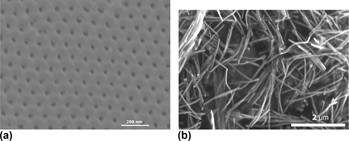Crossref Citations
This article has been cited by the following publications. This list is generated based on data provided by
Crossref.
Najafi, Mojgan
Assari, Parnaz
Rafati, Amir Abbas
and
Hamehvaisy, Mandana
2014.
Effect of the Electrodeposition Frequency, Wave Form, and Thermal Annealing on Magnetic Properties of [Co0.975Cr0.025]0.99Cu0.01 Nanowire Arrays.
Journal of Superconductivity and Novel Magnetism,
Vol. 27,
Issue. 12,
p.
2821.
Aguilera-Granja, Faustino
Montejano-Carrizales, Juan Martin
and
Vogel, Eugenio E.
2014.
Structural and electronic properties of magnetic cylinders at the atomic scale.
The European Physical Journal D,
Vol. 68,
Issue. 2,
Najafi, Mojgan
Rafati, Amir Abbas
Fart, Mona Khorshidi
and
Zare, Atefeh
2014.
Effect of the pH and electrodeposition frequency on magnetic properties of binary Co1−xSnx nanowire arrays.
Journal of Materials Research,
Vol. 29,
Issue. 2,
p.
190.
Najafi, M.
Alemipour, Z.
Hasanzadeh, I.
Aftabi, A.
and
Soltanian, S.
2015.
Influence of Annealing Temperature, Electrolyte Concentration and Electrodeposition Conditions on Magnetic Properties of Electrodeposited Co-Cr Alloy Nanowires.
Journal of Superconductivity and Novel Magnetism,
Vol. 28,
Issue. 1,
p.
95.
Gillette, Eleanor
Wittenberg, Stefanie
Graham, Lauren
Lee, Kwijong
Rubloff, Gary
Banerjee, Parag
and
Lee, Sang Bok
2015.
Anodization control for barrier-oxide thinning and 3D interconnected pores and direct electrodeposition of nanowire networks on native aluminium substrates.
Physical Chemistry Chemical Physics,
Vol. 17,
Issue. 5,
p.
3873.
Shaterabadi, Z.
Soltanian, S.
Koohbor, M.
Salimi, A.
and
Servati, P.
2015.
Modification of microstructure and magnetic properties of electrodeposited Co nanowire arrays: A study of the effect of external magnetic field, electrolyte acidity and annealing process.
Materials Chemistry and Physics,
Vol. 160,
Issue. ,
p.
389.
Jokar, A.
Ramazani, A.
Almasi-Kashi, M.
and
Montazer, A. H.
2016.
The roles of temperature and thickness of barrier layer in the electrodeposition efficiency of nickel inside anodic alumina templates.
Journal of Materials Science: Materials in Electronics,
Vol. 27,
Issue. 4,
p.
3995.
Najafi, Mojgan
2016.
Influence of Composition, pH, Annealing Temperature, Wave Form, and Frequency on Structure and Magnetic Properties of Binary Co1−x Al x and Ternary (Co0.97Al0.03)1−x Fe x Nanowire Alloys.
Journal of Superconductivity and Novel Magnetism,
Vol. 29,
Issue. 9,
p.
2461.
Aguilera-Granja, Faustino
Montejano-Carrizales, Juan Martin
and
Vogel, Eugenio E.
2016.
Structural and oxidation properties of CoNi nanowires.
The European Physical Journal D,
Vol. 70,
Issue. 6,
Srivastava, Suneel
and
Senapati, Samarpita
2017.
Advances in Magnetic Materials.
p.
67.
Najafi, Mojgan
Amjadi, Pezhman
and
Alemipour, Zahra
2017.
Fabrication and magnetic properties of ordered Co100−xPbxnanowire arrays electrodeposited in AAO templates: Effects of annealing temperature and frequency.
Journal of Materials Research,
Vol. 32,
Issue. 6,
p.
1177.
Astinchap, Bandar
Alemipour, Zahra
and
Faraji, Mohammad Jamil
2020.
Effects of pH and annealing on microstructure and magnetic properties of fabricated Co100-xWx nanowire arrays by AC electrodeposition.
Journal of Magnetism and Magnetic Materials,
Vol. 498,
Issue. ,
p.
166245.
Kashi, M Almasi
and
Montazer, A H
2022.
Template-based electrodeposited nonmagnetic and magnetic metal nanowire arrays as building blocks of future nanoscale applications.
Journal of Physics D: Applied Physics,
Vol. 55,
Issue. 23,
p.
233002.
Mottaghian, Sahar
Najafi, Mojgan
Abbas Rafati, Amir
and
Ali AsgharTerohid, Seyed
2023.
Structural, morphological, angular dependent of magnetic properties and FORC analysis of CoFeIn novel nanowire alloys.
Materials Science and Engineering: B,
Vol. 290,
Issue. ,
p.
116334.



